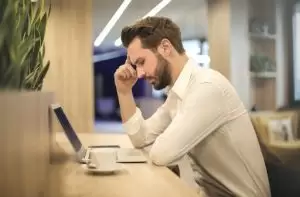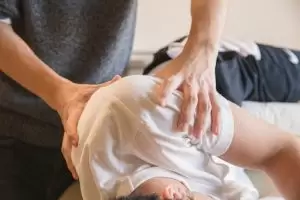As a child, did your parents ever scold you for slouching? Were you told to stand straighter? What was once thought of as nagging is actually some solid advice.
When you’re young, you don’t feel the effects of bad posture. You can sit crouched on the floor playing a video game for hours without so much as a twitch in your back.
As we age, however, that changes. Having poor posture adds extra stress to our bodies which can lead to anatomical changes in your spine. These changes lead to numerous issues such as the constriction of blood vessels and nerves and problems with your muscles, discs, and joints.
The end result? Back pain. Keep reading to learn how poor posture results in back pain and how you can improve your pain and posture.
Correct Posture vs. Poor Posture
Your spine has natural curves at your neck, mid-back, and low-back. When you have proper posture, you maintain these curves without increasing them. Think head above shoulders and shoulders over hips.
When your spine is in proper alignment, your body’s weight can be evenly distributed along each vertebra. When your spine is overly curved, instead, the majority of that weight is focused on just a few vertebrae.
When you slouch, for example, the muscles, tendons, and joints in the lower back all have to work harder. What seems like a “lazy” method of sitting or standing actually puts added stress on your body.
Since posture is how you hold your body at all times, you can have improper posture while you’re walking, bending over, sitting, standing, and even sleeping.
If you spend a lot of time sitting or are just generally curious to know if you have poor posture, start paying extra attention to your body. If you have ongoing neck and back pain or have a “hunch back,” you may have poor posture.
You can also try the wall test. To do this, stand against the wall with about six inches of space between your heels and the wall. If you have good posture, your head, shoulders, and butt will make contact with the wall. You should also have about two inches of space between your lower back and neck.
Several factors can affect your posture. The most common causes of poor posture include injuries, muscle weakness, stress, improper footwear, and occupational demands.
Here are common habits that are examples of poor posture:
- Sitting on unsupportive furniture
- Lying on your stomach
- Hunching forward when sitting
- Improperly lifting heavy objects
- Leaning on one leg
- Sitting for extended periods of time
- Living a sedentary lifestyle
There are two ways to classify how you hold your body: dynamic and static. Dynamic posture is how you hold your body while you are moving around, while static posture refers to how you hold yourself when you are still.
Any type of poor posture, whether dynamic or static, can cause back pain.

How Poor Posture Causes Back Pain
When you have incorrect posture, your body can develop stress areas within your muscle tissue, spinal joints (lumbar facets), and discs. Sometimes the stress is relieved when you correct your posture. Other times, the stress may accumulate and slowly weaken that area.
Prolonged Hunching
If you frequently hunch over when standing or sitting, you can strain your back, core, and abdominal muscles. This, in turn, reduced the blood supply in that area. When that happens, you can slowly develop stiffness and weakness in your lower back.
Unsupported Sitting
Sitting in an unsupported position creates a small forward bend in your spine. Eventually, this bend can place an unnecessary load on your lower spinal discs, leading to herniation.
Improper Lifting
When it comes to lifting heavy objects, an incorrect technique can cause lumbar disc herniation. A herniated lumbar disc can aggravate a nerve, causing back pain and potential pain and nerve symptoms down the leg.
Leaning on One Leg
When you lean on one leg while standing, you place excessive pressure on one hip. This causes your abductor to overwork and your gluteal muscles to weaken, leading to muscle imbalance in the pelvis. This causes pain in the lower back, hip, buttocks, neck, and shoulders.
Prolonged Sitting
Sitting for extended periods of time affects intrinsic and extrinsic muscles, causing them to weaken and overstretch. Excessive sitting also shortens hip flexors, interrupts blood circulation, and puts uneven weight on your discs.
Lying on Belly
Reading or working on a laptop while lying on your stomach can cause your lower back and hip to bend backward excessively, changing the dynamics of your lower spine curve.
Not only can poor posture result in back pain, but it can also exacerbate existing issues. If you already have a herniated disc or pinched nerve, poor posture can worsen your symptoms and prolong the healing process.
How to Prevent Back Pain from Poor Posture
Here are some tips for how you can prevent and reduce back pain resulting from bad posture:
- Avoid slouching when you sit or stand
- Ensure work surfaces are at an appropriate height
- Stretch before and after exercise and physical activity
- Don’t sit for extended periods without standing
- Sleep on a firm surface
- Wear comfortable, low-heeled shoes
- Practice low-impact exercises
Exercises that focus on body awareness can help improve posture. Yoga is a great example. You can also add core-strengthening exercises (crunches, planks, etc.) that can also benefit your posture.

Physical Therapy for Bad Posture Back Pain
Physical therapy is a great way to relieve back pain caused by poor posture. In addition to treating your back pain, a physical therapist can work with you to develop good posture habits. Once you can feel what good posture is, it is easier to maintain it throughout the day.
Your physical therapist will likely give you both passive and active treatments to help your back pain. Treatments may include but are not limited to
- Deep tissue massage
- Hot and cold therapies
- Transcutaneous electrical nerve stimulation (TENS)
- Dry needling
- Joint mobilization
- Corrective exercises and movements to improve flexibility, strength, and posture
- Activity modification advice
Improve Your Posture with Mid-County Physical Therapy
At Mid-County Physical Therapy, our physical therapists will design an individualized treatment plan based on your specific needs. We specialize in treating neck and back pain by getting to the root cause.
If you are suffering from back pain caused by poor posture, don’t suffer any longer. Schedule an appointment with Mid-County Physical Therapy today to find relief.


